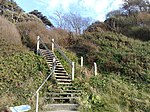The Needles Batteries
Artillery battery fortifications in the United KingdomCoastal fortificationsCold War sitesForts on the Isle of WightGrade II listed buildings on the Isle of Wight ... and 7 more
Grade II listed fortsMilitary and war museums in EnglandMuseums on the Isle of WightNational Trust properties on the Isle of WightPalmerston FortsUse British English from June 2015Vague or ambiguous time from February 2021

The Needles Batteries are two military batteries built above the Needles stacks to guard the West end of the Solent. The field of fire was from approximately West South West clockwise to Northeast and they were designed to defend against enemy ships.
Excerpt from the Wikipedia article The Needles Batteries (License: CC BY-SA 3.0, Authors, Images).The Needles Batteries
Geographical coordinates (GPS) Address Nearby Places Show on map
Geographical coordinates (GPS)
| Latitude | Longitude |
|---|---|
| N 50.66213 ° | E -1.58399 ° |
Address
England, United Kingdom
Open on Google Maps










